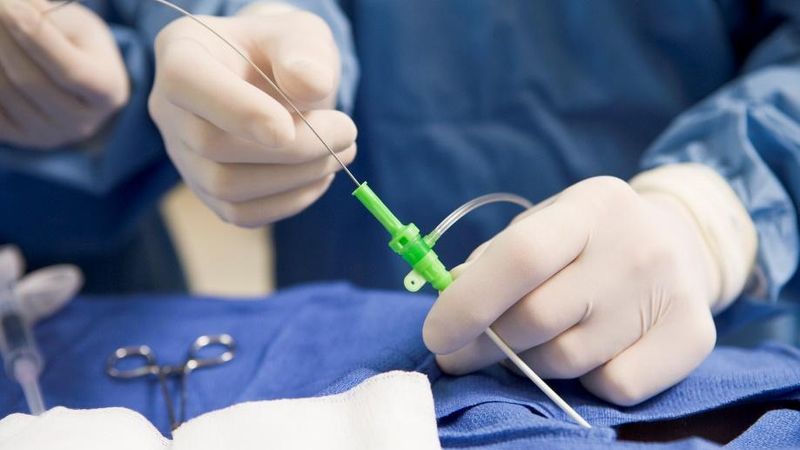Sensing and Energy Systems for Minimally Invasive Cardiovascular Surgeries
Article #3 of Improving Lives with Digital Healthcare Series: Using real-time sensing, new energy sources, and multifunctional connectors, it's possible to carry out cardiovascular operations with reduced risks and faster recovery time.
This is the third article in an 8-part series featuring articles on Improving Lives with Digital Healthcare. The series focuses on electronic systems that enable innovation in the healthcare industry. This series is sponsored by Mouser Electronics. Through the sponsorship, Mouser Electronics shares its passion for technologies that enable smarter and connected applications.
Cardiovascular diseases are among the leading causes of premature deaths globally, accounting for 17.9 million deaths in the year 2019.[1] Advancements in biomedical instrumentation and engineering have made it possible for doctors and surgeons to treat patients and save them from some of the most complicated conditions considered incurable in the past.
This article presents an overview of how new sensing, communication, and energy systems, engineered for the healthcare sector can be used to transform cardiovascular disease treatment procedures.
Precise, Accurate, and Real-Time Sensing for Cardiovascular Procedures
To diagnose and deliver the best therapy and monitor patients after treatment, engineers working on the latest generation of cardiovascular devices are taking full advantage of microelectronics. Improvements in these electronic systems allow designers to integrate multiple modalities within the same instrument.
An example of such a sophisticated biomedical instrument is a cardiovascular catheter. It is a commonly used tool that includes a flexible tube directed through a blood vessel to the heart to diagnose or treat certain cardiac diseases such as clogged arteries or irregular heartbeats.[2] The device provides treatment, diagnosis, and monitoring capabilities. Combining different functions into a single cardiovascular catheter enhances the possibilities of minimally-invasive surgery. The integration of multiple modalities in devices like cardiac catheters brings with it considerable complexities.
Sensors are vital in understanding the patient’s anatomy, with some devices incorporating more than 300 electrodes. Each of these electrodes needs to be connected via a cable to the 3D mapping system. A large number of wires and cables required means the connectors need to feature high contact densities while also delivering superior performance. The voltages detected by these electrodes can be very faint, so contacts with high reliability and low contact resistance are essential to prevent the signal from being lost.
These new medical devices must be flexible and adaptable. Every person is different, and their anatomy is unique. Physicians must be able to capture a complete understanding of individual differences with the latest sensors that collect accurate information and generate a high-resolution mapping of the patient’s physiology. This advancement in visualization enables faster diagnosis.
By reviewing the impact of the procedure even while it is still underway, surgeons can be provided with instantaneous feedback on the treatment results. This feedback allows the therapy to be delivered more effectively, reducing the need for post-operative care and the chance that the procedure might have to be repeated.
New Energy Sources Facilitate Minimally Invasive Cardiovascular Surgeries
Modern sensors enable physicians to deliver treatments with a high degree of accuracy and take advantage of new energy sources for ablation. Doctors are turning to innovative energy sources and advanced sensing technologies to guide diagnosis, treatment, and post-treatment monitoring. Microwaves, cryoenergy, and even lasers allow physicians to treat patients using minimally invasive techniques that deliver great clinical outcomes.
Once the physicians are armed with the complete picture of their patient’s needs, they provide therapy that will selectively destroy cells within the heart that create abnormal electrical signals. It is imperative that the treatment precisely targets the damaged cells while preserving healthy tissue, and this is among the reasons why new energy sources are so important. The latest instruments can deliver the energy with pinpoint accuracy while monitoring the effects in real-time.
The latest technologies allow doctors to operate without the risk of complications with open-heart surgery. Traditional risks to the patient that are reduced with the new procedures include the possibility of strokes, post-operative infections, and long recovery times. Minimally invasive operating technologies improve the patient’s experience by reducing the need for extensive post-operative care, lengthy hospital stays, and consequently, their expenses too.
Hybrid Connectors for Reliable Data Exchange in Biomedical Electronics
Along with low-voltage signal contacts, connectors must deliver the energy needed for the latest technologies. Radio Frequency (RF) energy sources and imaging catheters utilizing transducers need dedicated coaxial contacts. The potential use of lasers means that fiber optic contacts offer the ideal method to deliver therapy, bringing with them yet another form of contact. Optical fibers can also provide illumination and collect high-resolution imagery, providing physicians with the real-time feedback critical to their chances of success.
Therefore, the ideal connector solutions for cardiovascular medical devices are typically hybrid, designed to accommodate different contact types. Hybrid connectors can employ a mix of high-density signals, high-power signals, RF, and optical fiber contacts, all within a single assembly that combines compact design and ease of use.
Molex Connectivity Solutions Power Next-Gen Healthcare Technologies
Molex offers a range of connectors that have been designed specifically for use in the medical industry. Configurable connectors and cable assemblies provide the ability to create customized solutions for the latest generation of cardiovascular surgical equipment.

Molex MediSpec Medical Plastic Circular (MPC) Interconnect System combines premium performance and ease of use to meet the stringent standards of medical devices. MediSpec MPC connectors utilize a Molex contact system to ensure a reliable electrical interface and 10,000 mating cycles. MediSpec connectors offer push-pull engagement with a unique locking sleeve.
Conclusion
Doctors armed with the latest biomedical instruments can now diagnose and treat cardiovascular diseases more precisely. This minimizes the time taken for the patient to recuperate and reduces the strain on overburdened hospitals. The potential for tailored medical care is limitless as sensors grow more accurate and connectivity systems get better.
This article was initially published by Mouser and Molex in an e-magazine. It has been substantially edited by the Wevolver team and Electrical Engineer Ravi Y Rao. It's the third article from the Improving Lives with Digital Healthcare Series. Future articles will introduce readers to some more interesting applications of electronics in healthcare.
Introductory article covered the fundamentals of biomedical instruments and the ways in which digitizing them is transforming healthcare.
Article 1 explored the design challenges in Consumer and Medical wearables. It showcased how technologies once limited to hospitals are now made available to everyone for monitoring personal health.
Article 2 was focused on the present state of robotic surgery. It explained how advancements in robotics and communication, combined with the expertise of surgeons, enable customized treatments for patients.
Article 3 presents an overview of how new sensing, communication, and energy systems, engineered for the healthcare sector can be used to transform cardiovascular disease treatment procedures.
Article 4 examined Brain-Computer Interfaces and how they help in enhancing human vision, motor recovery for disabled limbs, and more.
Article 5 featured an informative webchat between Mike Depp, and Glen Capek from Molex, as they discussed trends in flexible electronics driving new solutions for medical wearables applications.
Article 6 discussed how immersive digital technologies like Augmented Reality (AR) and Virtual Reality (VR) make medical learning more engaging through lifelike experiences.
Final article was a roundup of the entire series that tried to give readers a snapshot of the potential of medical technologies in the present times.
About the sponsor: Mouser Electronics
Mouser Electronics is a worldwide leading authorized distributor of semiconductors and electronic components for over 1,100 manufacturer brands. They specialize in the rapid introduction of new products and technologies for design engineers and buyers. Their extensive product offering includes semiconductors, interconnects, passives, and electromechanical components.
References
[1] Cardiovascular diseases (CVDs), 11 June 2021, World Health Organization [Online], Available from: https://www.who.int/en/news-room/fact-sheets/detail/cardiovascular-diseases-(cvds)
[2] Cardiac Catheterization, WebMD, [Online], Available from: https://www.webmd.com/heart-disease/cardiac-catheterization1
About Mouser Electronics
Mouser Electronics is a worldwide leading authorized distributor of semiconductors and electronic components for over 1200 industry-leading manufacturers. We specialize in the rapid introduction of...
202 Posts



